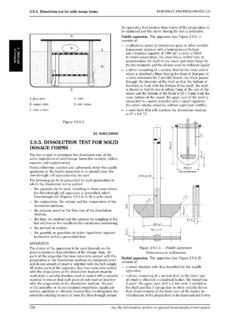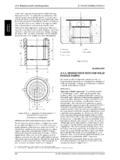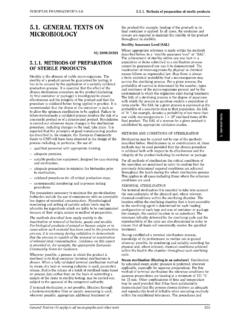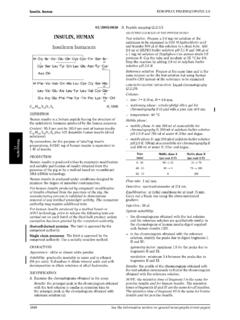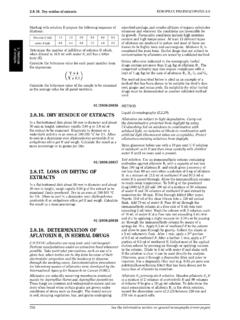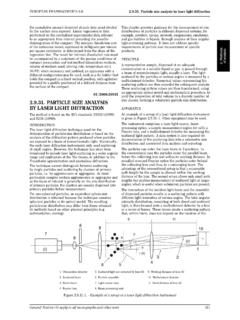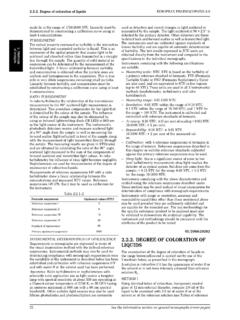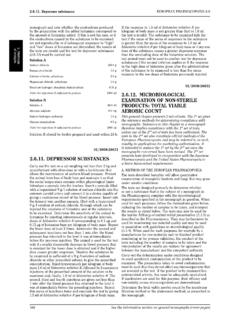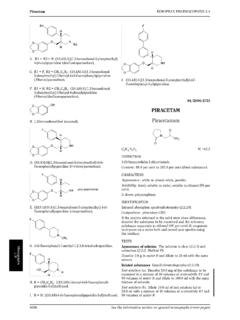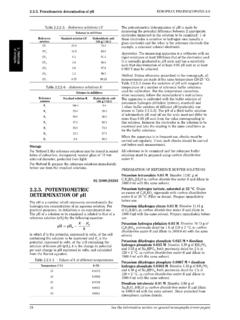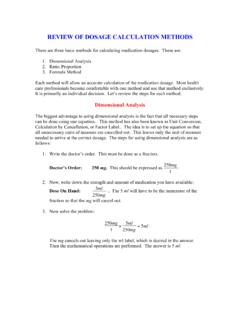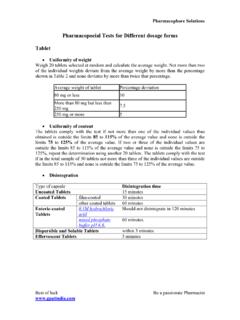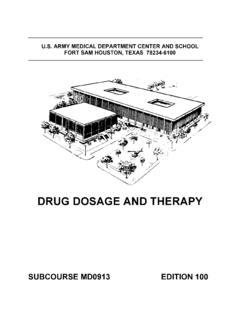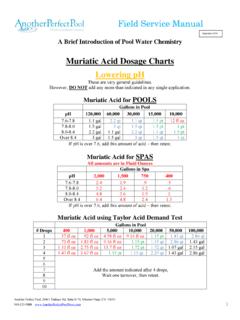Transcription of 2.9.40. UNIFORMITY OF DOSAGE UNITS - …
1 EUROPEAN PHARMACOPOEIA UNIFORMITY of DOSAGE unitsFigure Funnel(dimensions in millimetres)Figure Guide (section G-G)(dimensions in millimetres)The gum is artificially chewed by the horizontal pistons, andthe vertical piston ensures that the gum stays in the rightplace between speed is controlled to ensure a constant cycle. Onecycle (chew) is defined as follows: the horizontal pistonsstart from their outermost position, move to their innermostposition and back to their outermost position. Within onecycle, the vertical piston moves from its lowest position to itsuppermost position and back to its lowest horizontal piston has a stroke of mm. Themaximum distance between these 2 pistons is 50 minimum distance between the 2 horizontal pistonsis mm to mm. The vertical piston has a stroke piston movement is controlled, so that the2 pistons are at their innermost position at the same piston movement is controlled, so it does not conflictwith the movement of the horizontal necessary, the machine can be constructed so that thehorizontal pistons rotate around their own axes in oppositedirection to each other by the end of the chew in order toobtain maximum parts of the apparatus that may come in contact with thepreparation or the dissolution medium are chemically inertand do not adsorb, react or interfere with the each determination, the following information is needed: composition, volume and temperature of the dissolutionmedium, numberofchewsperminute, time and sampling method, whether the analysis is performed on the gum residue oron the dissolution medium, method of the prescribed volume of dissolution medium inthe chewing chamber, usually 20 ml ofphosphate buffersolution pH R2.
2 Maintain the medium temperature at37 C using an electrical device with external the piston speed at the prescribed number of chews perminute (usually 60). Accurately weigh a portion of gum orthe whole gum, put it into the chewing chamber and startthe AND EVALUATIONStop the apparatus at the prescribed time. Remove the content of active substance(s) by a suitablemethod. Medium replacement may be made after eachsampling procedure; compensation by calculation of mediumvolume change or sample dilution is needed. Alternatively,determine the content of active substance(s) remainingin the gum residue. Carry out the test successively on6 medicated chewing quantity of active substance(s) dissolved in a specifiedtime is expressed as a percentage of the content stated onthe UNIFORMITY OFDOSAGE UNITSTo ensure the consistency of DOSAGE UNITS , each unit ina batch should have an active substance content withina narrow range around the label claim. DOSAGE UNITS aredefined as DOSAGE forms containing a single dose or a partof a dose of an active substance in each DOSAGE unit .
3 Theuniformity of DOSAGE UNITS specification is not intendedto apply to suspensions, emulsions, or gels in single-dosecontainers intended for cutaneous term UNIFORMITY of DOSAGE unit is defined as thedegree of UNIFORMITY in the amount of the active substanceamong DOSAGE UNITS . Therefore, the requirements of thischapter apply to each active substance being comprisedin DOSAGE UNITS containing one or more active substances,unless otherwise specified elsewere in this of 2 methods: content UNIFORMITY or mass variation(see Table ).The test for content UNIFORMITY of preparations presentedin DOSAGE UNITS is based on the assay of the individualcontents of active substance(s) of a number of DOSAGE unitsGeneralNotices(1) UNIFORMITY of DOSAGE unitsEUROPEAN PHARMACOPOEIA determine whether the individual contents are within thelimits set. The content UNIFORMITY method may be applied inall forms:(1) solutions enclosed in single-dose containers and in softcapsules;(2) solids (including powders, granules and sterile solids)that are packaged in single-dose containers and contain noactive or inactive added substances;(3) solids (including sterile solids) that are packaged insingle-dose containers, with or without active or inactiveadded substances, that have been prepared from truesolutions and freeze-dried in the final containers and arelabelled to indicate this method of preparation.
4 (4) hard capsules, uncoated tablets, or film-coated tablets,containing 25 mg or more of an active substance comprising25percentormore,bymass,ofthedo sageunitor,inthe case of hard capsules, the capsule contents, exceptthat UNIFORMITY of other active substances present in lesserproportions is demonstrated by meeting content test for content UNIFORMITY is required for all dosageforms not meeting the above conditions for the massvariation test. Alternatively, products that do not meetthe 25 mg/25 per cent threshold limit may be tested foruniformity of DOSAGE UNITS by mass variation instead ofthe content UNIFORMITY test on the following condition:the concentration Relative Standard Deviation (RSD) ofthe active substance in the final DOSAGE UNITS is not morethan 2 per cent, based on process validation data anddevelopment data, and if there has been regulatory approvalof such a change. The concentration RSD is the RSD ofthe concentration per DOSAGE unit (m/morm/V), whereconcentration per DOSAGE unit equals the assay result perdosage unit divided by the individual DOSAGE unit mass.
5 Seethe RSD formula in Table UNIFORMITYS elect not less than 30 UNITS , and proceed as follows used for assay of the preparation and for the contentuniformity test, it may be necessary to establish a correctionfactor to be applied to the results of the DOSAGE forms. Assay 10 UNITS individually using anappropriate analytical method. Calculate the acceptancevalue (see Table ).Liquid DOSAGE forms. Assay 10 UNITS individually usingan appropriate analytical method. Carry out the assay onthe amount of well-mixed material that is removed from anindividual container in conditions of normal use. Expressthe results as delivered dose. Calculate the acceptance value(see Table ).Calculation of Acceptance ValueCalculate the Acceptance Value (AV)usingtheformula:in which the terms are as defined in Table VARIATIONC arry out an assay for the active substance(s) on arepresentative sample of the batch using an appropriateanalytical method. This value is resultA,expressedaspercentage of label claim (see Calculation of AcceptanceValue).
6 Assume that the concentration (mass of activesubstance per mass of DOSAGE unit ) is uniform. Select notless than 30 DOSAGE UNITS , and proceed as follows for thedosage form or film-coated tablets. Accurately weigh 10 tabletsindividually. Calculate the active substance content,expressed as percentage of label claim, of each tablet fromthe mass of the individual tablets and the result of the the acceptance capsules. Accurately weigh 10 capsules individually,taking care to preserve the identity of each capsule. Removethe contents of each capsule by suitable means. Accuratelyweigh the emptied shells individually, and calculate for eachcapsule the net mass of its contents by subtracting the substance content in each capsule from the mass ofproduct removed from the individual capsules and the capsules. Accurately weigh 10 intact capsulesindividually to obtain their gross masses, taking care topreserve the identity of each capsule. Then cut openthe capsules by means of a suitable clean, dry cuttinginstrument such as scissors or a sharp open blade, andremove the contents by washing with a suitable Application of Content Unformity (CU) and Mass Variation (MV) test for DOSAGE formsDosage formsTypeSub-TypeDose and ratio of active substance 25 mg and 25 percent<25mgor<25percentTabletsuncoatedM VCU coatedfilm-coatedMVCU othersCUCUC apsuleshardMVCU softsuspensions, emulsions, gelsCUCU solutionsMVMVS olids in single-dosecontainerssingle componentMVMV multiple componentssolution freeze-dried in finalcontainerMVMV othersCUCUS olutions enclosed insingle-dose containersMVMVO thersCUCU3118 See the information section on general monographs (cover pages)EUROPEAN PHARMACOPOEIA UNIFORMITY of DOSAGE unitsTable of individual contents (x1,x2.)
7 ,xn), expressed as a percentageof the label claimx1,x2,..,xnIndividual contents of thedosage UNITS tested, expressedas a percentage of the label claimnSample size (number ofdosage UNITS in a sample)Ifn=10, constantIfn=30, standard deviationRSDR elative standard deviation(the sample standard deviationexpressed as a percentage ofthe mean)If per cent percent, thenM=(AV=ks)M(case 1)To be applied whenT valueIf< ,thenM= (AV= +ks)If> ,thenM= (AV= +ks)If per cent T,thenM=(AV=ks)M(case 2)To be applied whenT> valueIf< ,thenM= (AV= +ks)If>T,thenM=Tper cent(AV= T+ks)Acceptance value (AV)General formula:Calculations are specified abovefor the different allowed acceptance valueL1= allowed range fordeviation of each DOSAGE unit testedfrom the calculated value ofMOnthelowside,nodosageunitresult can be less than the high side, no DOSAGE unitresult can be greater than (This is based onL2value of )L2= test sample amount attime of manufactureAllow the occluded solvent to evaporate from the shells atroom temperature over a period of about 30 min, takingprecautions to avoid uptake or loss of moisture.
8 Weigh theindividual shells, and calculate the net contents. Calculatethe active substance content on each capsule from the massof product removed from the individual capsules and theresult of the assay. Calculate the acceptance DOSAGE forms other than tablets and ,treatingeachunitasdescribed therein. Calculate the acceptance DOSAGE forms. Accurately weigh the amount ofliquid that is removed from each of 10 individual containersin conditions of normal use. If necessary, compute theequivalent volume after determining the density. Calculatethe active substance content in each container from the massof product removed from the individual containers and theresult of the assay. Calculate the acceptance (1) UNIFORMITY of DOSAGE unitsEUROPEAN PHARMACOPOEIA of Acceptance Value. Calculate the acceptancevalue (AV) as shown in content UNIFORMITY , except thatthe individual contents of the UNITS are replaced with theindividual estimated contents defined ,x2,..,xn=individual estimated contents of thedosage UNITS tested,wherew1,w2.
9 ,wn=individual masses of the DOSAGE unitstested,A=content of active substance (percentage oflabel claim) obtained using an appropriateanalytical method,=mean of individual masses (w1,w2,..,wn).CRITERIAA pply the following criteria, unless otherwise and liquid DOSAGE forms. The requirements for dosageuniformityaremetiftheacceptanceval ueofthefirst10dosageunitsislessthanorequ altoL1. If the acceptancevalue is greater thanL1,testthenext20dosageunitsandcalcul ate the acceptance value. The requirements are met ifthe final acceptance value of the 30 DOSAGE UNITS is less thanor equal toL1 and no individual content of the DOSAGE unitis less than (1 L2 )Mnor more than (1 +L2 )Min calculation of acceptance value under content uniformityor under mass variation. Unless otherwise specified,L1is andL2 is the information section on general monographs (cover pages)
